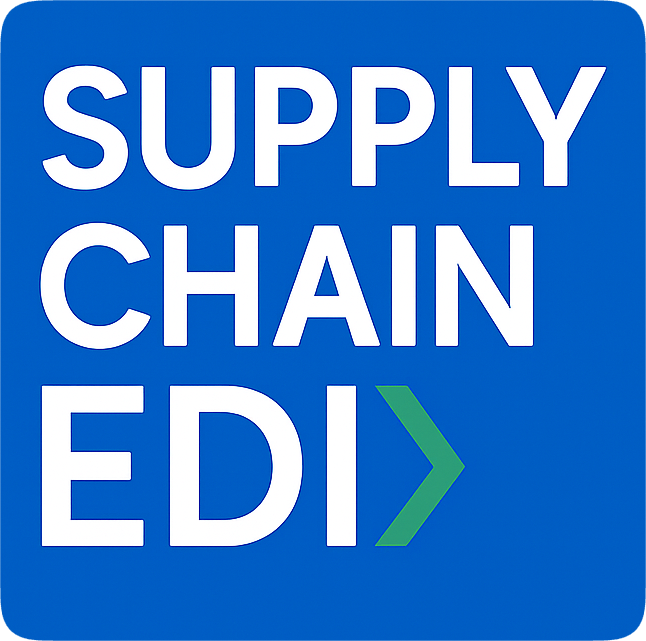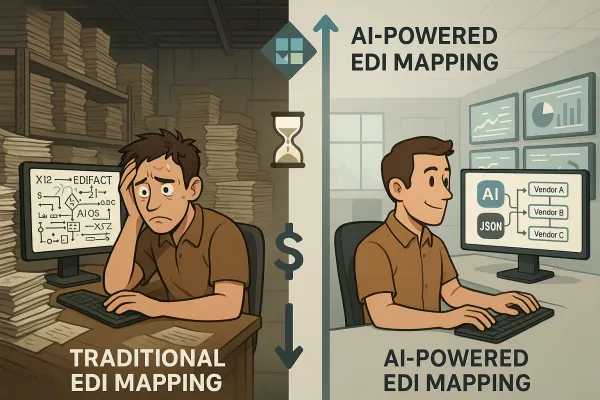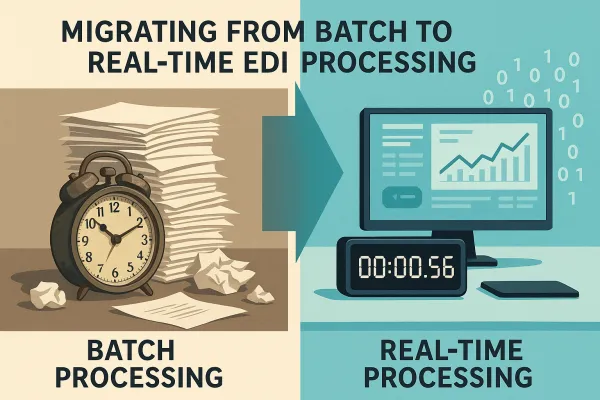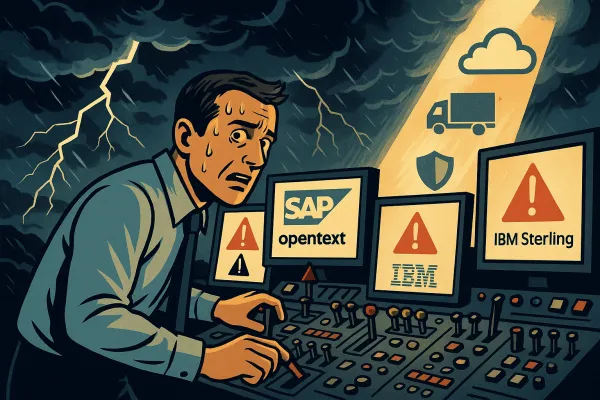The EDI Vendor Consolidation Crisis: Your Complete 2025 Survival Guide for Choosing the Right Integration Partner
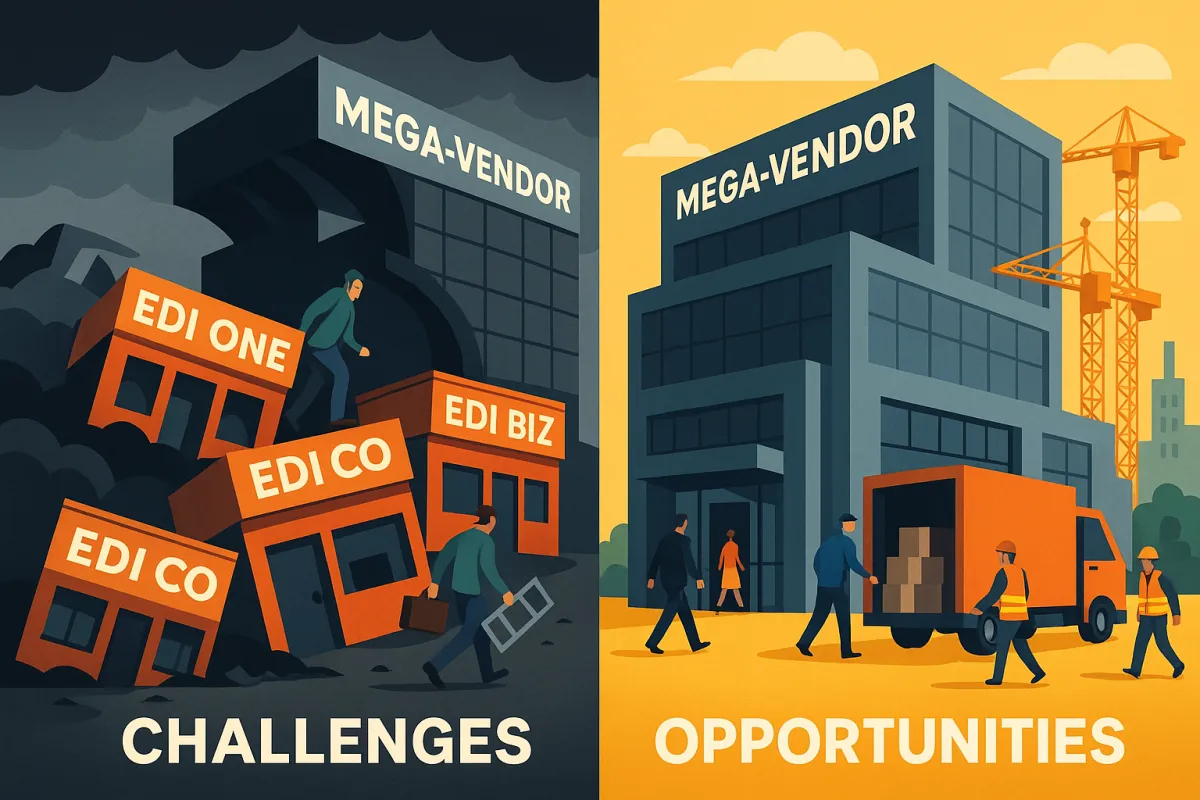
The EDI market faces an unprecedented consolidation crisis that's reshaping how supply chain professionals select and manage integration partners. SPS Commerce's €68.35 million acquisition of TIE Kinetix in 2023 represents just one example of the accelerating vendor consolidation that's creating both challenges and opportunities for EDI managers navigating an increasingly concentrated marketplace.
You're dealing with fewer vendor options, rising prices, and the constant threat of service disruption as smaller players get absorbed or shut down. But there's a strategic framework that can help you turn this consolidation crisis into a competitive advantage.
The EDI Vendor Consolidation Crisis: Understanding the New Landscape
The numbers tell a stark story. As of late August, roughly 125 tech mergers and acquisitions with channel implications occurred in 2025, with EDI providers facing particular pressure. Omdia expects the technology advisor market to experience "aggressive" consolidation soon, and EDI isn't immune to this trend.
Major players are rapidly expanding through acquisitions. SPS Commerce acquired both TIE Kinetix and The Order Exchange within weeks of each other in 2023, demonstrating how quickly the landscape can shift. Meanwhile, 2025 has been marked by large technology services companies acquiring smaller ones to meet demand in AI, cloud, cybersecurity, and managed services.
This consolidation creates a domino effect. When a vendor gets acquired, contracts change, pricing structures shift, and service levels fluctuate during integration periods. While most aspects of your relationship with acquired companies will remain the same initially, acquisitions help advance supply chain initiatives by offering access to broader trading communities and expanded capabilities.
The consolidation isn't just about size – it's about geographic expansion and capability gaps. TIE Kinetix had the majority of its business in continental Europe whereas SPS' business was concentrated in the Americas and Asia, allowing for continued development and growth of the combined business.
Why Consolidation Creates Risk (And Opportunity) for EDI Managers
Vendor consolidation presents a double-edged sword. On the risk side, you face concentration risk when too many of your critical suppliers get absorbed into a handful of mega-vendors. Partners face compensation reduction, contract revisions and personnel turnover as vendor consolidation sweeps across the channel. This affects not just pricing but service quality during transition periods.
The talent drain compounds the problem. According to Jett McCandless, co-founder and CEO of project44, staffing an EDI project will definitely be the bigger challenge as no one that graduated with a computer science degree in the last 10 years has been trained on EDI. When acquisitions happen, experienced EDI professionals often leave, creating knowledge gaps.
But consolidation also creates opportunities. Larger vendors often offer broader geographic coverage, deeper integration capabilities, and more comprehensive security frameworks. AI consolidation is accelerating, with strategic buyers racing to acquire infrastructure, tooling, proprietary models, engineering teams and inference capacity, creating a wave of smaller, technology tuck-in deals.
Budget pressures from finance teams are driving much of this consolidation. Technology spending continues to increase in AI, cloud computing, data analytics, and cybersecurity, with M&A deal volume expected to increase in the technology services sector for the remainder of 2025 and into 2026.
The 2025 EDI Vendor Evaluation Framework: 8 Critical Decision Factors
Navigate vendor consolidation with a systematic evaluation framework that prioritizes long-term flexibility over short-term savings:
1. Integration Architecture Flexibility
Look for vendors supporting hybrid EDI-API approaches. The future of EDI lies in hybrid cloud platforms that combine traditional EDI with API-based integrations, allowing businesses to modernize without disrupting their existing trading partner networks. This flexibility prevents vendor lock-in while enabling gradual modernization.
2. Acquisition Track Record
Evaluate how potential vendors have handled previous acquisitions. Access to the industry's broadest trading community, which to date includes more than 120,000 trading partners in over 80 countries becomes more valuable when vendor consolidation limits your options.
3. Geographic and Regulatory Coverage
Consider vendors with multi-region capabilities. TIE Kinetix has made significant investments in e-invoicing and has a pole position in the European e-invoicing market, which is expected to grow strongly with mandatory application of e-invoicing in the BTG and BTB markets in Europe over the next 2-4 years.
4. Technology Stack Modernization
Assess AI readiness and cloud-native capabilities. The rise of Agentic AI is redefining what EDI can do, with the standardized nature of EDI formats requiring less data cleaning before feeding into AI models, allowing supply chain leaders to embed autonomous AI agents into EDI workflows.
5. ERP Integration Breadth
Verify compatibility with your current and planned ERP systems. APIs that work with EDI and can connect to common ERPs like SAP S/4HANA, Oracle Fusion, NetSuite, and MS Dynamics 365 are essential for businesses seeking agile, efficient, and future-ready supply chain integration.
6. Transport Management Platform Connectivity
Evaluate integration capabilities with TMS vendors like MercuryGate, Descartes, Transporeon, and innovative platforms like Cargoson that offer modern API-first architectures alongside traditional EDI support.
7. Financial Stability and Exit Strategy
Assess vendor financial health and have contingency plans. A substantial wave of exits looms on the horizon as numerous technology services businesses acquired during the pandemic period approach their investment maturity, likely to catalyze increased deal flow.
8. Compliance and Security Framework
Ensure robust security standards and regulatory compliance capabilities, especially for international operations.
Pricing Model Revolution: Transaction vs Partner-Based Models
The consolidation wave is accelerating a fundamental shift in EDI pricing models. Traditional transaction-based pricing is giving way to partner-based models that better align with how modern supply chains actually operate.
Smaller businesses tend to opt for third-party EDI services that charge a few cents per purchase order, but as companies get larger and make more orders, when you're paying 10-15 cents per PO and doing a thousand or two thousand of them because we're becoming more of a drop-ship type world, they may find this approach no longer works.
This shift toward volume creates opportunities for negotiating better rates during vendor selection. Look for providers offering flexible pricing tiers that scale with your transaction volumes without penalty thresholds that could lock you into expensive overages during peak periods.
Partner-based pricing models charge based on the number of active trading relationships rather than individual transaction volumes. This approach provides more predictable budgeting and encourages deeper integration with key suppliers, but requires careful evaluation of your partner portfolio growth projections.
Hidden costs in consolidated vendor relationships often emerge during contract renewals. Professional services fees, data storage charges, and premium support costs can accumulate quickly. Budget frameworks should include 15-20% contingency for unexpected fees during vendor transitions.
The Hybrid Integration Strategy: EDI + API + TMS
Smart EDI managers are moving beyond either/or thinking about EDI versus APIs. A hybrid approach offers flexibility, helping organizations modernize without disrupting existing workflows or supply chain operations, enabling seamless automation, universal trading partner connectivity, and real-time supply chain visibility.
The most successful implementations combine EDI's structured reliability with APIs' real-time capabilities. EDI and API are complementary technologies that work best together, with API integration augmenting EDI and giving deeper context to B2B integrations while EDI helps enable downstream business processes and data orchestration.
Here's how hybrid strategies work in practice: APIs may be necessary to look up catalog inventory or check pricing within an eCommerce platform, but if a customer decides to make the order, EDI may be necessary to kick-start the ordering, shipping, and fulfillment processes.
TMS integration becomes particularly valuable in hybrid environments. Modern platforms like Cargoson provide API-driven connectivity alongside established TMS providers, creating multiple integration pathways that reduce dependence on any single vendor approach.
API-EDI hybrid models are becoming more popular in fast-paced markets because they make it easier to scale, enroll partners quickly, and follow new digital rules, making the supply chain more visible and helping partners work together better.
This hybrid approach future-proofs your infrastructure against further consolidation. If your primary EDI vendor gets acquired and service degrades, you maintain operational continuity through API connections while transitioning to alternative providers.
Due Diligence Checklist: Avoiding Vendor Lock-in While Maximizing Integration
Thorough due diligence becomes more critical when vendor options are limited. Focus on these key areas:
Financial Health Assessment: Request audited financials for the past three years. Look for consistent revenue growth, manageable debt levels, and diversified customer bases that aren't overly dependent on specific industries or geographic regions.
Technology Roadmap Alignment: Evaluate the vendor's development priorities against your integration needs. The rapid integration of generative artificial intelligence (AI) solutions to EDI is boosting automated data mapping and increasing adoption across businesses. Ensure your potential vendor is investing in AI capabilities rather than just maintaining legacy systems.
Customer Reference Verification: Speak with at least three current customers who have similar transaction volumes and complexity. Ask specifically about support responsiveness during outages, contract negotiation flexibility, and how vendor acquisitions affected their operations.
Data Portability Guarantees: Negotiate explicit data export provisions in your contract. This includes transaction histories, mapping configurations, and partner onboarding templates. Some vendors make data extraction expensive or technically difficult during vendor transitions.
Service Level Agreement Specificity: Define precise uptime requirements with financial penalties for non-compliance. Include provisions for communication protocols during planned maintenance and unplanned outages.
Escalation Path Documentation: Establish clear escalation procedures that bypass standard support queues during critical issues. Get direct contact information for technical decision-makers, not just account managers.
Future-Proofing Your EDI Infrastructure in a Consolidated Market
The EDI market is experiencing explosive growth despite consolidation concerns. The global Electronic Data Interchange (EDI) software market size was valued at USD 2.08 billion in 2024 and is projected to grow from USD 2.31 billion in 2025 to USD 5.30 billion by 2032, exhibiting a CAGR of 12.6%.
AI integration is driving much of this growth. With structured, complete, and accurate EDI data, supply chain leaders can embed autonomous AI agents into EDI workflows to alert, interpret, act on, and optimize data in real time, moving away from manual troubleshooting toward using AI to free up resources for bigger supply chain challenges.
The hybrid segment is expected to grow with the highest CAGR during the forecast period as hybrid EDI enables B2B transactions with much less infrastructural limitation than conventional EDI. This validates the strategic importance of hybrid integration approaches.
Position your organization to benefit from consolidation rather than just survive it. Build relationships with multiple vendor ecosystems, including emerging players like Cargoson that offer modern TMS integration alongside established EDI providers. This diversity provides negotiating leverage and operational flexibility.
Consider the geographic implications of vendor consolidation. North America dominated the global electronic data interchange software market with a share of 52.4% in 2024, but Asia Pacific is expected to grow with the highest CAGR. Your vendor selection should account for these geographic growth patterns.
Despite forecasts of EDI disappearing, it's not only here to stay but is set to expand, with the global EDI market projected to value $49213.1 million by 2027. The technology isn't dying – it's evolving. Your vendor selection strategy should focus on partners who understand this evolution rather than those treating EDI as legacy technology.
The key to thriving during vendor consolidation is preparation. Develop internal expertise that's independent of any specific vendor platform. Document your integration requirements in vendor-neutral terms. Build relationships with multiple service providers before you need them. Most importantly, view consolidation as an opportunity to negotiate better terms and capabilities rather than just a threat to manage.
